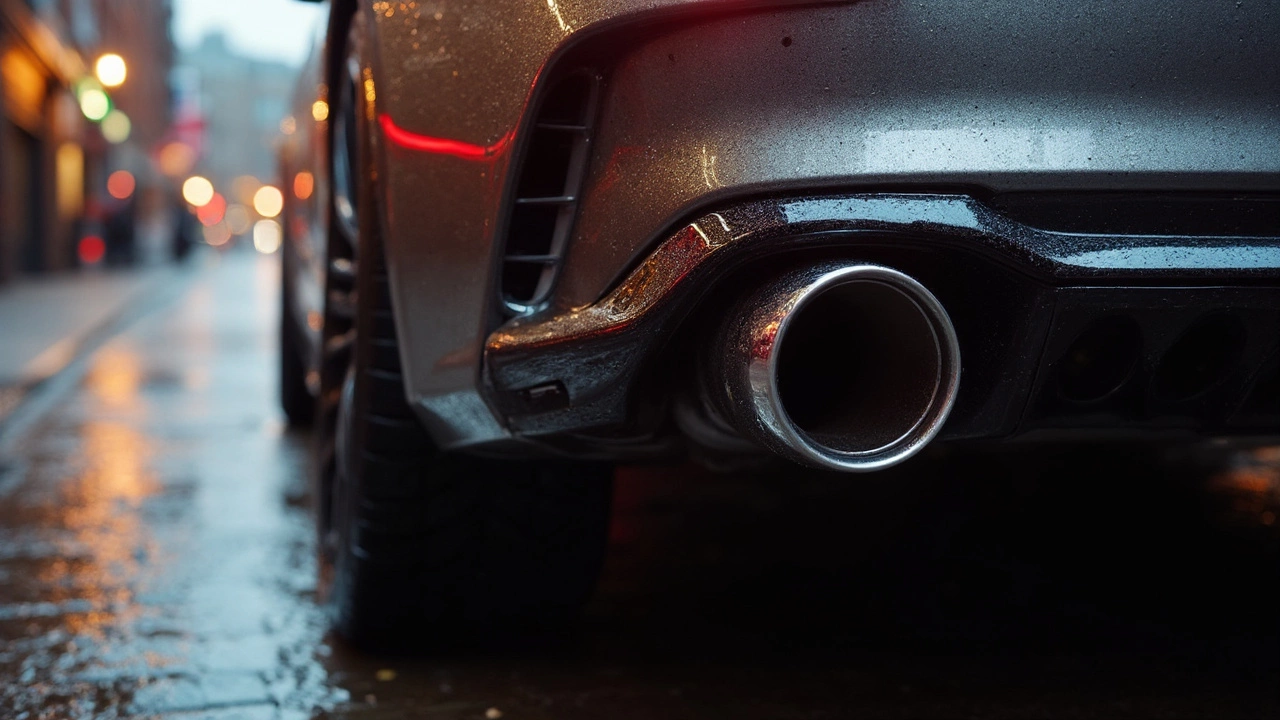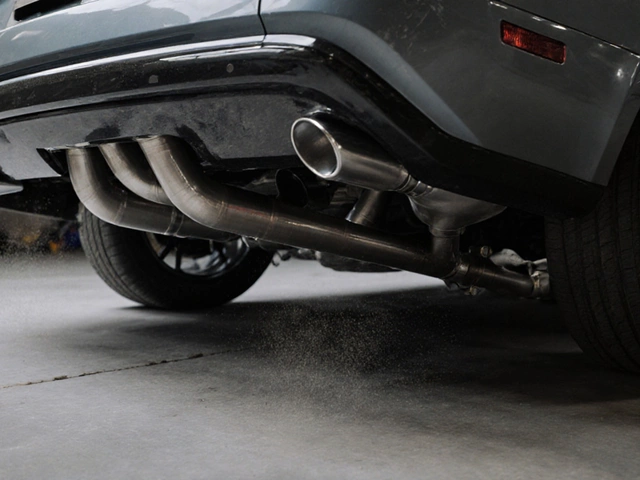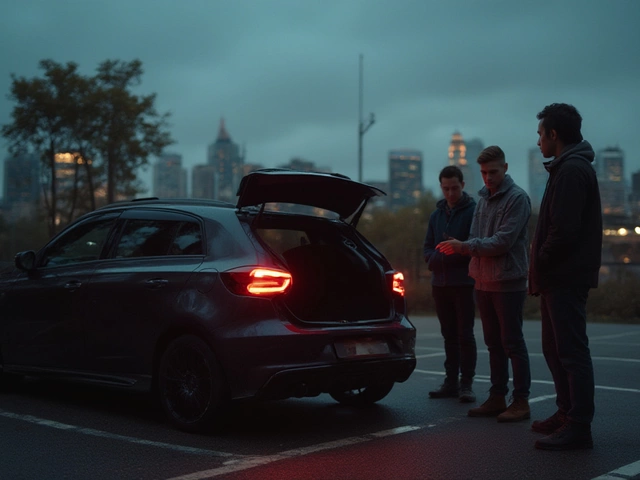Ever wondered why some cars have more than one silencer stuck along their exhaust? You’ve probably heard about double silencers at a car meet or from someone who’s into custom exhaust setups, but the idea sounds a bit mysterious at first.
Here’s the simple truth: a double silencer setup is all about controlling exhaust noise and balancing performance. It uses two mufflers (that’s what most people mean by ‘silencers’) instead of the usual one, each taking a turn cutting down on the sound that comes out of the tailpipe. But it’s not just about being quieter. Some setups use different types or sizes of silencers to tune the noise and airflow just how you want it—louder, deeper, or even sneakily quiet.
This isn’t just for show cars or for folks dodging noise laws. Double silencers can make a world of difference in daily driving, especially if you want a performance exhaust but don’t want your neighbors glaring every morning. There are plenty of details to consider—like backpressure, drone, and the right fit for your engine—but once you get the basics, you can actually control the vibe (and volume) of your car with a few smart choices in the exhaust department.
- Double Silencer: The Basics
- How a Double Silencer Impacts Performance and Sound
- Pros, Cons, and Common Myths
- Choosing or Upgrading: Key Tips
Double Silencer: The Basics
A double silencer system is pretty much what it sounds like: two mufflers set up in your car’s exhaust. It’s not just some trend you’ll see at car shows—for a lot of builds, it solves legit problems. The whole idea is to manage how much noise comes out the back, but also to fine-tune things like backpressure and airflow depending on what you want or need for your driving habits.
Usually, you’ll find a double silencer setup in one of two ways. First, there’s the double silencer on a single exhaust pipe—two mufflers lined up in series, with exhaust gas passing through both before it exits. Second, there’s the dual-exit style, often on V6 or V8 engines, where each exhaust bank gets its own silencer. Here’s a quick breakdown of what you might see:
- In-series double silencer: Two mufflers back-to-back on one pipe.
- Parallel/dual exhaust double silencer: One silencer per exhaust branch, usually on twin-pipe setups.
Not all silencers are created equal, either. Some are straight-through designs (louder, less restrictive), while others use chambers and baffles (quieter, can add backpressure). Which ones you pick depends on whether you want to keep your ride quiet or want more of that loud, throaty sound.
It’s not just aftermarket cars that use this system. Lots of manufacturers slap double silencers onto family wagons, SUVs, or even turbocharged cars straight from the factory—especially when they want good performance but need to keep things neighbor-friendly.
| Vehicle Type | Purpose of Double Silencer |
|---|---|
| Sports Cars | Reduce drone, control loudness, tweak performance |
| Family Sedans/SUVs | Cut noise for comfort, keep emissions in check |
| Turbocharged Engines | Control high exhaust flow, reduce harsh tones |
If you’re eyeing a custom exhaust for your ride, understanding why and how double silencers work is step one to actually getting the results you want—whether that’s lower volume, better sound quality, or a touch more performance without annoying the whole street.
How a Double Silencer Impacts Performance and Sound
Let’s get right to it: adding a double silencer to your exhaust does a lot more than just hush up the noise. The first silencer usually knocks down the harshest sounds and shakes, while the second one goes after any leftover noise and tones. These setups can shape not only how loud your car is, but also what kind of rumble or growl you get at the tailpipe. Some folks even go for a deeper, bass-heavy note without making the car stupid loud, just by mixing different types of silencers.
So, what’s happening under the hood? Two silencers stack up to fight noise, but they also add a little more restriction to how exhaust gases move out of the engine. More restriction can sometimes mean a small dip in horsepower, especially on turbocharged cars, but it’s not always a deal-breaker. Many well-made double silencer systems keep this penalty minimal by using high-flow materials or clever designs. Here’s a quick table showing what you might see on the dyno and the decibel meter when switching from a single-silencer to a double-silencer setup, based on real-world tests from aftermarket manufacturers:
| Setup | Power Change | Decibel Level (Idle) | Decibel Level (Full Throttle) |
|---|---|---|---|
| Stock Single Silencer | Reference (0hp change) | 71 dB | 86 dB |
| Aftermarket Single Silencer | +4 to +7hp | 77 dB | 95 dB |
| Aftermarket Double Silencer | +2 to +5hp | 70 dB | 88 dB |
Here’s another angle: double silencers really shine on long road trips. They help kill off that annoying drone at highway speeds—much easier on your ears and your sanity, especially in small cars or hatchbacks where sound sneaks right into the cabin. On the downside, if you’re chasing every bit of horsepower, you might give up a few horses with an extra silencer in place, but with modern designs, you rarely lose enough to notice unless you’re on the track.
If you’re after a performance boost with a bit of stealth, some tuners use a high-flow first silencer and a chambered second one. This combo gives decent gains and tones down the rasp that comes from straight pipes. Pick wisely and you can get a custom exhaust that whispers when you want but sings when you floor it. The trade-off? A few less decibels—sometimes just what you need to keep your neighbors or the cops happy.
- Want more volume? Stick with a single high-flow silencer, but expect more noise inside and out.
- Crave less drone and less hassle? Double silencers give you an easy win, especially for daily drivers.
- Mixing silencer types changes the sound character—glasspacks for growl, chambers for rumble, or both for a custom blend.

Pros, Cons, and Common Myths
So, is a double silencer setup really worth it, or is it all hype? Let’s cut through the noise with the real facts, common misunderstandings, and a look at both the upsides and the tradeoffs.
- Pro: Better Noise Control — Two silencers almost always mean less noise, especially the higher-pitched harsh stuff most people hate. If you commute early or live somewhere strict about car sound limits, this can save you plenty of headaches and maybe even fines.
- Pro: Tuning Options — With two mufflers, exhaust builders can mix and match styles. You can pair a chambered silencer up front with a straight-through at the back if you want a deeper rumble, or go for twin straight-throughs to keep some bark but lose the drone.
- Pro: Smoother Exhaust Flow (Sometimes) — Certain setups can help smooth out pulses in the exhaust, which can make the car feel a bit nicer in daily driving, especially for turbo engines.
- Con: Added Weight and Complexity — Two silencers mean more piping, more brackets, and more weight. It might not matter much for a street car, but if you’re chasing every kilo on a track build, this could be a dealbreaker.
- Con: Possible Power Loss — With every extra restriction, there’s a chance for more backpressure, which can rob a little horsepower on the top end if the silencers aren’t well-matched to your engine size and build.
- Con: Higher Cost — Double the parts, double the labor. Don’t expect a custom double silencer setup to come cheap, especially if stainless or fancy brands are involved.
Here’s a quick look at some data that gives you the real-world numbers behind double silencers compared to single muffler setups:
| Exhaust Setup | Average Sound Level (dB) | Estimated Backpressure (kPa) | Cost Range (USD) |
|---|---|---|---|
| Single Silencer | 92 | 18 | $350–$650 |
| Double Silencer | 81 | 25 | $600–$1300 |
Now for some of the stuff people get wrong:
- Myth: Double silencers kill performance every time. That’s not always true. If the system’s diameter is matched to the engine and the silencers aren’t overly restrictive, daily drivers won’t notice any major power hit.
- Myth: Two mufflers always mean dead-quiet exhaust. Not quite. The design and packing inside matter a lot. Two straight-through mufflers will still let you hear the engine—just less sharply.
- Myth: Only luxury cars use double silencers. You’ll spot this setup on plenty of sporty cars, turbo builds, and even trucks wanting a mellow sound—all for different reasons.
Before dropping cash on a custom setup, weigh what matters most: sound, power, or price. Don’t fall for common myths—talk with a reputable muffler shop and know exactly what you want out of your exhaust.
Choosing or Upgrading: Key Tips
Getting a double silencer isn’t just about stacking two mufflers and hoping for the best. There’s a bit of thinking involved if you want your car to sound right and run smooth. Here are some real-world tips for picking out or upgrading your setup.
- Double silencer setups can affect backpressure, so match your silencer sizes to your engine type. For a small four-cylinder, going too big can mess with low-end torque. On bigger engines, the extra flow isn’t usually a problem.
- Pay attention to silencer positioning. The first muffler (closer to the engine) usually kills off the rough, high-frequency sound, while the rear muffler can shape the tailpipe note—think deep growls or mellow hums.
- If you want performance as well as less noise, look for free-flow or straight-through silencers, but only if your setup’s legal where you live. Not all locations let you blast down the street with a straight-out race muffler.
- Go for high-quality stainless steel or aluminized steel parts. Cheap metal rusts out fast, and you’ll be back to square one (and losing money) in no time.
- If you’re not sure about sizes, brands, or how to get it welded, talk to a shop that works on custom exhausts every week. They’ll know what works for your ride and your local laws.
- Don’t forget to look up noise and emissions rules in your city or state. Some places are strict about modifications—even if the setup actually cuts noise better than stock.
Pro tip: record your current exhaust sound before you start. You’ll actually hear the difference later, and you’ll know right away if the new setup is what you wanted or just a waste of cash. Always mind the fit—nothing ruins a driveway install faster than finding out your new silencer is an inch too long or the pipes don’t line up.




